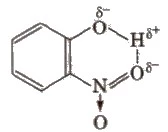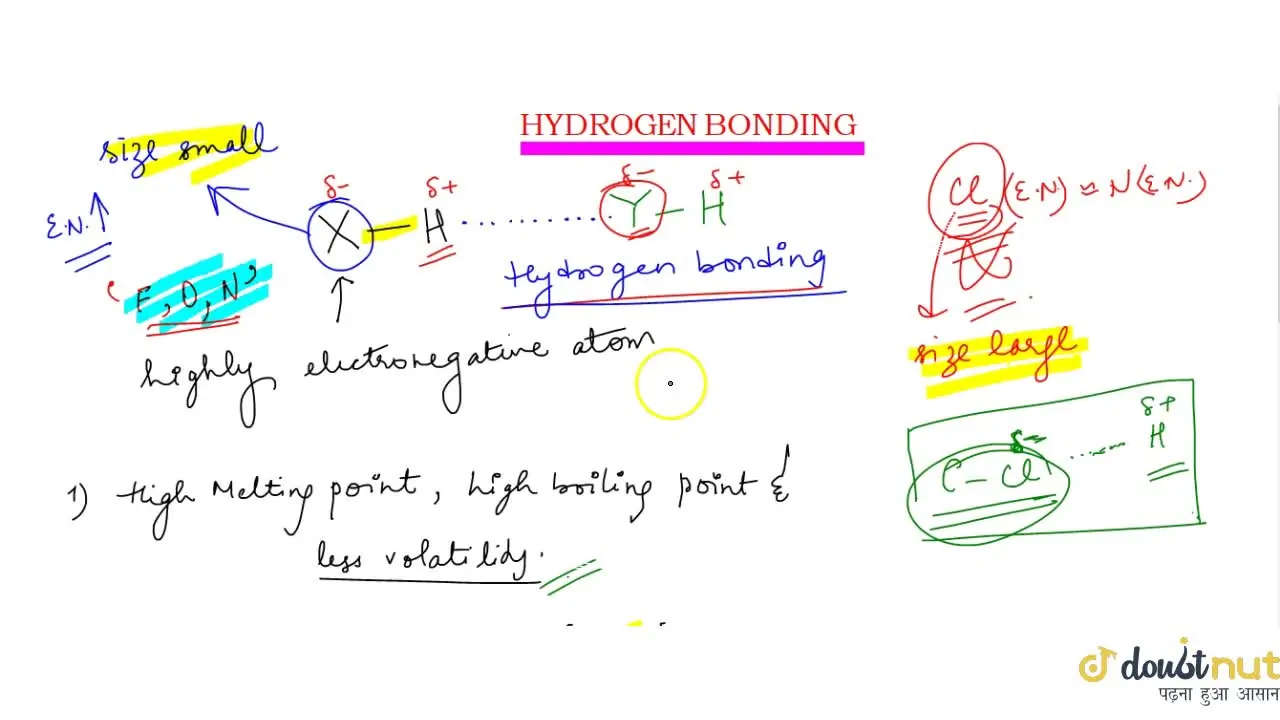Hydrogen Bonding
Hydrogen Bonding | Definition, Types, Examples & Applications
A chemical bond can be described as the forces of attraction that hold various chemical constituents (atoms, ions, etc.) together in the different chemical species.
Bonds are formed to get stability, and also with a release of energy.
What is Hydrogen Bonding?
A hydrogen bond is an attractive (dipole-dipole) force between a hydrogen atom and an electronegative atom bonded to another electronegative atom. This type of bonding always involves a hydrogen atom. Hydrogen bonds can be formed between molecules or within constituents of a single molecule.
A hydrogen bond is stronger than van der Waals forces but weaker than ionic bonds or covalent bonds. It is about 1/20th (5%) the magnitude of the covalent bond formed between O-H. However, even the particular weak bond is strong enough to bear a slight temperature fluctuation.
A dotted line represents a hydrogen bond. The chains have a zig-zag structure.

The hydrogen bond is purely electrostatic and a weak bond. The strongest hydrogen bond has a strength of about 5-10 kcal per mol. The higher the electronegativity of atom involved in H-bonding, the stronger is the bond strength.
In a polar bond, one-side of the organizes still exerts a small positive charge, while the other side has a small negative electrical charge. Forming a bond does not neutralize the electrical nature of the involved atoms.
Examples of Hydrogen Bonds
Hydrogen bonds can be found in nucleic acids between base pairs and between water molecules. The particular type of bond also forms between hydrogen atoms and carbon atoms of different chloroform molecules, between hydrogen atoms and nitrogen atoms of neighboring ammonia molecules, and between hydrogen atoms and oxygen atoms in acetylacetone. Several organic molecules are subject to hydrogen bonds.
Hydrogen bond helps in binding transcription factors to DNA. It aids antigen-antibody binding. This type of bond organizes polypeptides into secondary structures, such as alpha-helix and beta-sheet. It holds together the two strands of DNA and binds transcription factors to each other.
Hydrogen Bond in Water
Though hydrogen bonds form between a hydrogen atom and any other electronegative atom, the bonds within water molecules are the most ubiquitous. Hydrogen bonds form between neighbouring water molecules when the hydrogen of one atom comes between the oxygen atoms of its own molecule and that of its neighbour. It occurs because the hydrogen atom is attracted to both its own oxygen atom and the other oxygen atoms that come near enough. The oxygen nucleus has 8 positive charges; therefore, it attracts electrons better than the hydrogen nucleus, with its single positive charge. So, neighbour oxygen molecules are capable of attracting hydrogen atoms from other molecules, and thus forming the basis of hydrogen bond formation.
The overall number of hydrogen bonds formed between water molecules is 4. A single water molecule can form 2 hydrogen bonds between the oxygen atom and the two hydrogen atoms in the molecule. Two additional bonds can be formed between each hydrogen atom and neighboring oxygen atoms.
Hydrogen bonds have a tendency to arrange in a tetrahedron around every water molecule, resulting in the crystal structure of snowflakes.
In the liquid state of water, the distance between adjacent molecules is more and also the energy of the water molecules is high enough that hydrogen bonds are often stretched and broken. However, even liquid water molecules balance out to a tetrahedral arrangement. Due to hydrogen bonding, the structure of liquid water molecule becomes ordered at a lower temperature, far beyond that of other liquids. Hydrogen bonding keeps water molecules about 15% closer than if the hydrogen bonds weren't present. The hydrogen bonds are the primary reason water displays distinctive chemical properties.
- Hydrogen bonding decreases extreme temperature changes near large bodies of water.
- Hydrogen bonding enables animals to cool themselves by means of perspiration because such a huge amount of heat is needed to disrupt hydrogen bonds between water molecules.
- Hydrogen bonding allows water to stay in the liquid state over a broader temperature range than for any other comparable-sized molecule.
- It gives water a remarkably high heat of vaporization, which means substantial thermal energy is needed to change liquid water into water vapour.
Hydrogen bonds inside heavy water are stronger than those within ordinary water made using normal hydrogen (protium). However, hydrogen bonding within tritiated water is stronger still.
Types of Hydrogen Bonds
There are two types of hydrogen bond:
(i) Intermolecular H-bonding: This type of H-bonding involves two or more molecules.
(ii) Intramolecular H-bonding: This type of H-bonding occurs within a molecule.
Applications of Intermolecular H-bonding
(i) Melting and boiling point of water: Water has the lowermost molecular weight among the hydrides of group 16 elements, but it has the highest melting and boiling points. It is because of the intermolecular H-bonding in the water molecule, H2O.
(ii) Ice has less density than liquid water: Each water molecule within a crystal structure of ice is associated with four other water molecules by H-bonding in a tetrahedral structure. After melting, the H-bonds in ice is broken, resulting in a decrease of space between water molecules and an increase of water density up to 4o C. Above 4°C more H-bonds are broken. The distance between the two water molecules increases and the density again decreases. Thus, water has a maximum density at 4°C.
(iii) Melting point and boiling point of alcohol: The difference between the melting point and boiling point of alcohol is also due to H-bonding.
Applications of Intramolecular H-bonding
(i) Volatile character of nitrophenols: o-nitrophenol is more volatile (b.p. 214°C) as compared to meta (b.p. 290°C) and para (b.p. 279°C). It is because of chelation.

Chelation is not feasible in meta and para isomers due to the formation of the desired size of the ring.


Similar Questions
Chemical Bonding - Hydrogen Bond
View SolutionLondon Forces And Hydrogen Bond
View SolutionHydrogen bond energy is equal to :
View SolutionHydrogen bond energy is equal to :
View SolutionHydrogen bond is maximum in .
View SolutionHydrogen bond is an example for
View SolutionHydrogen bond energy is equal to
View SolutionHydrogen bond energy is equal to
View SolutionHydrogen bond energy is equal to :
View SolutionCoordination number of hydrogen in a hydrogen bond is
View Solution


